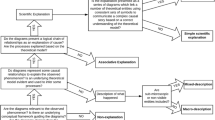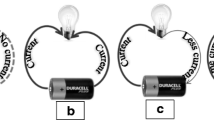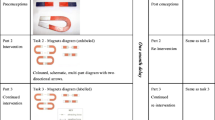Abstract
Diagrams are considered a powerful strategy for understanding and problem-solving. Self-explanation is believed to be behind the effectiveness of diagrams. However, it is not clear to what extent students engage in self-explanation. The possibility that students do not always engage in self-explanation is suggested by empirical studies showing that diagrams do not always produce efficacious outcomes. Ichikawa [1] also argued that it is unclear how students interpret diagrams and discussed the need to have students explain themselves using diagrams. In science learning, diagrams effectively help students learn the principles behind phenomena. Having students use diagrams to explain phenomena may help them understand the principles of the phenomena correctly and integrate their knowledge effectively across subject areas. Therefore, in this study, we developed lesson instructions in which students were required to explain the phenomenon using diagrams after the teacher had explained it. Students were also given the opportunity to solve the problem collaboratively after the explanation had been provided. The study involved 71 8th-grade students in one school. Fifty-eight same grade students from a traditional public school also participated in the study and served as the control group. A “basic knowledge test”, which tested students’ knowledge in a fill-in-the-blank format, and a “principle understanding test” and “transfer test,” which tested students’ knowledge in an explanation format, were administered. The results demonstrated no significant difference in the basic knowledge test, but the score in the principle understanding test and the transfer knowledge test was higher for the students who received the experimental instruction. This study indicates that deeper understanding is facilitated by combining the experience of using diagrams with peer explanation.
You have full access to this open access chapter, Download conference paper PDF
Similar content being viewed by others
1 Introduction
While the traditional goal of education has focused on solving problems efficiently, recent changes in global educational goals have made it more essential to promote deeper learning among students. This “deeper learning” involves conceptual understanding and the transfer of learned knowledge in different contexts.
Diagrams may play an important function in achieving this goal. Diagrams have been considered a valuable strategy for problem-solving and suitable tools for communication. However, they may also be important as a tool to promote deeper understanding. In particular, diagrams may help in learning the principles behind phenomena in science learning (e.g., [2]). They may help students understand phenomena correctly and integrate knowledge effectively across subject areas.
As for the reason why diagrams contribute to promoting deeper learning, Ainsworth and Th Loizou [3] argued that diagrams facilitate self-explanation. However, some studies have shown that diagrams are not always effective (e.g., [4]), so not everyone spontaneously self-explains when using the diagrams taught. Ichikawa [1] also argued that it is unclear how students interpret diagrams and discusses the need for students to explain what they have learned using diagrams.
When considering how diagrams are used in the classroom, many teachers actively use them in instruction. However, the activity in which students themselves explain the principle with the use of diagrams is not always done sufficiently. For example, although teachers teach problem solving well with the use of diagrams in Japan, not much time is given to students for them to explain what they have learned using diagrams as teachers do, or to solve applied problems using diagrams. However, under these circumstances, students may not correctly understand the principles underpinning the phenomena. If teachers want to share the principles behind the phenomena with more students, they need to allow students to explain themselves with diagrams.
Based on the awareness of these issues, in this study, educational psychologists and teachers in school collaboratively designed and conducted a science class in which students got opportunities to explain the principle behind the phenomena they were learning with diagrams. The important point is that the teacher explains to students by using diagrams and ensures that the students themselves have the opportunity to explain using diagrams. We also examined the effect of the instruction compared to the traditional style of instruction in schools (i.e., this study is a practice-based research).
2 Outline of Practice Proposed in this Study
This practice was conducted at a public junior high school in the Kanto region of Japan. The class concerned a one-hour science class for 8th-grade students. The first instructional plan was written by the second and third authors, who are public school teachers, and it was later modified in discussions with other authors including psychologists.
There were two major topics to be covered in the class. One was “sea winds and land winds”, and the other was “monsoons”. A common principle can explain both. More specifically, due to the difference in specific heat between the ground and water, during relatively hot weather (daytime or summer), an updraft rises from the ground (land or content) and a downdraft is generated in the water (ocean), and that causes the wind to blow from the ocean to the land. On the other hand, during relatively cold periods (night time and winter), updrafts are generated in the water (ocean) and downdrafts are generated on the ground (land and continents), and that causes winds to blow from the land to the sea. Visual representation for understanding this was given.
Students with only a shallow understanding might memorize this content as a one-to-one correspondence, so that they just remember the facts of “sea breezes during the day” and “land breezes at night”. They might also memorize that “the Japanese monsoon blows from the southwest in summer and from the northeast in winter”. On the other hand, students with deeper understanding comprehend the principle behind the winds through strategies such as diagram use so that they can remember and reconstruct those wind movements from the principle and remember the contents for a longer time.
The explanations of the phenomena and the principle are usually included in the textbook, which is often accompanied by diagrams, and many teachers explain to students with the use of diagrams in class. However, as mentioned in the introduction, it is not sufficient for many students to simply listen to the explanations by a teacher. It might be necessary to give students opportunities to explain the principle and the phenomena by themselves with diagrams. Therefore, in this practice, activities were incorporated during which students explained the content to their peers with the use of diagrams. The content relating to seasonal winds is not only covered in the 8th-grade science class but also in social studies. For example, the monsoon in India is included in the 7th-grade social studies curriculum. However, it is thought that such deep understanding across subjects is not sufficiently covered in class. Therefore, activities that required consideration of the monsoon in other areas of the world, with diagram use, were also included in the class session as applied problem-solving.
The “thinking-after-instruction” approach proposed by Ichikawa [1] was used in these teaching methods. This teaching method consists of four stages: teacher's explanation, checking comprehension, deepening understanding, and reflection (Fig. 1). This framework was used to design the lesson. More specifically, the following flow of lessons was conducted. (1) The teacher explained the phenomena of sea wind and land wind, and the principle that explained the wind movement direction. (2) The students checked their understanding of “sea wind and land winds” with each other. Specifically, using diagrams, the students checked whether they could explain the phenomena and the principle behind them in their own words (see Fig. 1). (3) The teacher explained the phenomena and the principle of the Japanese monsoon. (4) The students checked their understanding of the Japanese monsoon with each other. Using diagrams, they checked whether they could explain the phenomena and the principle behind them in their own words. (5) Students worked in groups to think about the monsoons in Southeast Asia, India, and Africa. (6) Representative students were asked to explain the phenomena and the principle by taking on the role of TV newscasters. (7) As a reflection activity, the teacher asked the students to write on paper what they understood, what they still did not understand well, and what they wanted to know more about.
This study also took data from classes from a normal public school in Tokyo to obtain comparable control group data. Seventy-one students participated in the survey in the practicing school and 58 students in the base-line group. The teacher explained the phenomena and a principle in the classes, and the students were asked to solve the problems in class or at home. For the students in this “base-line group”, the teacher explained the principle (as would be typical in most classrooms). There was no activity in which the students themselves explained the principle using diagrams. In addition, the importance of diagrams was not specifically mentioned, and the applied problem-solving was not included. To examine the effectiveness of this practice, a post-test was conducted 1 to 2 weeks after implementing the lesson.
3 Evaluation and Discussion
The post-test comprised three parts: the first part was a “basic knowledge test” which is fill-in-the-blank question; the second was a “principle understanding test” and the third was a “transfer test” that required descriptive answers. The first part was a question, in which students were asked to answer “sea wind” or “land wind” for daytime wind and night time wind. The second part had a question that asked students to explain the principle of why such differences in the wind occur according to the day/night time. The third part had a question requiring integrating the knowledge they learned in science and social study, in which students were asked to explain why the direction of the monsoon is different between Japan and India. The results are shown in Fig. 2. No difference was found in the “basic knowledge test”. On the other hand, “principle understanding test” and “transfer test” scores were higher in the classes where the practice was implemented than in the control group. Detailed results are shown in Fig. 2.
This study conducted a practice incorporating a learning activity in which students themselves explained using diagrams. The results showed that the students’ deeper understanding, such as explaining a principle, was promoted compared to the regular classes. The principle behind the phenomena was taught in both schools. In the control group, the teacher only used diagrams to explain. As a result, only some students who reached a deeper understanding on their own could explain the principle. On the other hand, in classes with practice developed in this study, many more students were able to explain the principle even though they were given only a few minutes to explain it using diagrams. In addition, the transfer test indicated that students got a comprehensive understanding across subjects. The present study was practice-based, and many areas have not been rigorously tested between the experimental and control groups. It is desirable to conduct a more detailed investigation of the effects of students’ own explanations using diagrams in the future.
References
Ichikawa, S.: Cognitive counseling to support Learning: A new intersection of psychology and education (1993)
Ainsworth, S., Prain, V., Tytler, R.: Drawing to learn in science. Science 26, 1096–1097 (2011)
Ainsworth, S., Loizou, A.T.: The effects of self-explaining when learning with text or diagrams. Cogn. Sci. 27(4), 669–681 (2003)
Van Essen, G., Hamaker, C.: Using self-generated drawings to solve arithmetic word problems. J. Educ. Res. 83(6), 301–312 (1990)
Author information
Authors and Affiliations
Corresponding author
Editor information
Editors and Affiliations
Rights and permissions
Open Access This chapter is licensed under the terms of the Creative Commons Attribution 4.0 International License (http://creativecommons.org/licenses/by/4.0/), which permits use, sharing, adaptation, distribution and reproduction in any medium or format, as long as you give appropriate credit to the original author(s) and the source, provide a link to the Creative Commons license and indicate if changes were made.
The images or other third party material in this chapter are included in the chapter's Creative Commons license, unless indicated otherwise in a credit line to the material. If material is not included in the chapter's Creative Commons license and your intended use is not permitted by statutory regulation or exceeds the permitted use, you will need to obtain permission directly from the copyright holder.
Copyright information
© 2022 The Author(s)
About this paper
Cite this paper
Uesaka, Y. et al. (2022). Explaining with Diagrams for Promoting Deeper Learning: School Practice to Integrate Knowledge Across Subjects. In: Giardino, V., Linker, S., Burns, R., Bellucci, F., Boucheix, JM., Viana, P. (eds) Diagrammatic Representation and Inference. Diagrams 2022. Lecture Notes in Computer Science(), vol 13462. Springer, Cham. https://doi.org/10.1007/978-3-031-15146-0_33
Download citation
DOI: https://doi.org/10.1007/978-3-031-15146-0_33
Published:
Publisher Name: Springer, Cham
Print ISBN: 978-3-031-15145-3
Online ISBN: 978-3-031-15146-0
eBook Packages: Computer ScienceComputer Science (R0)






